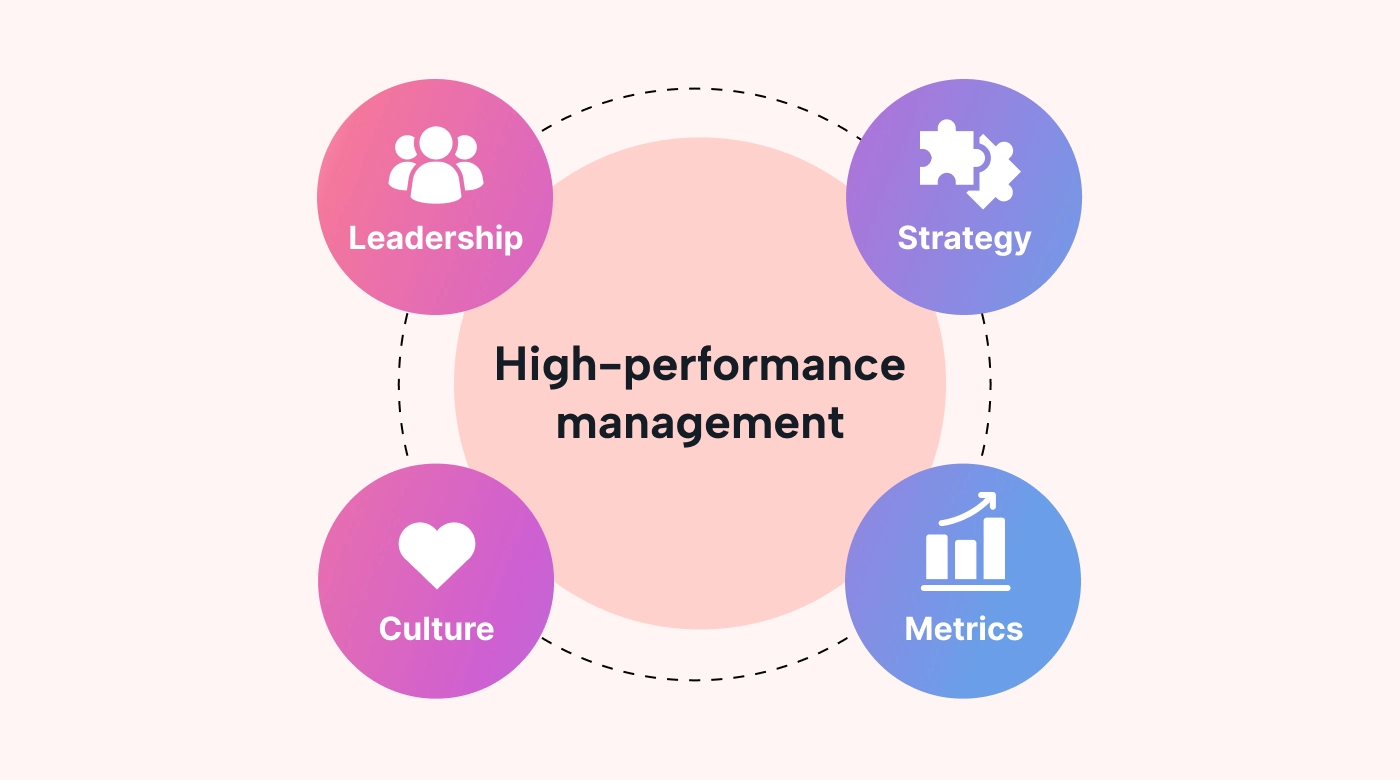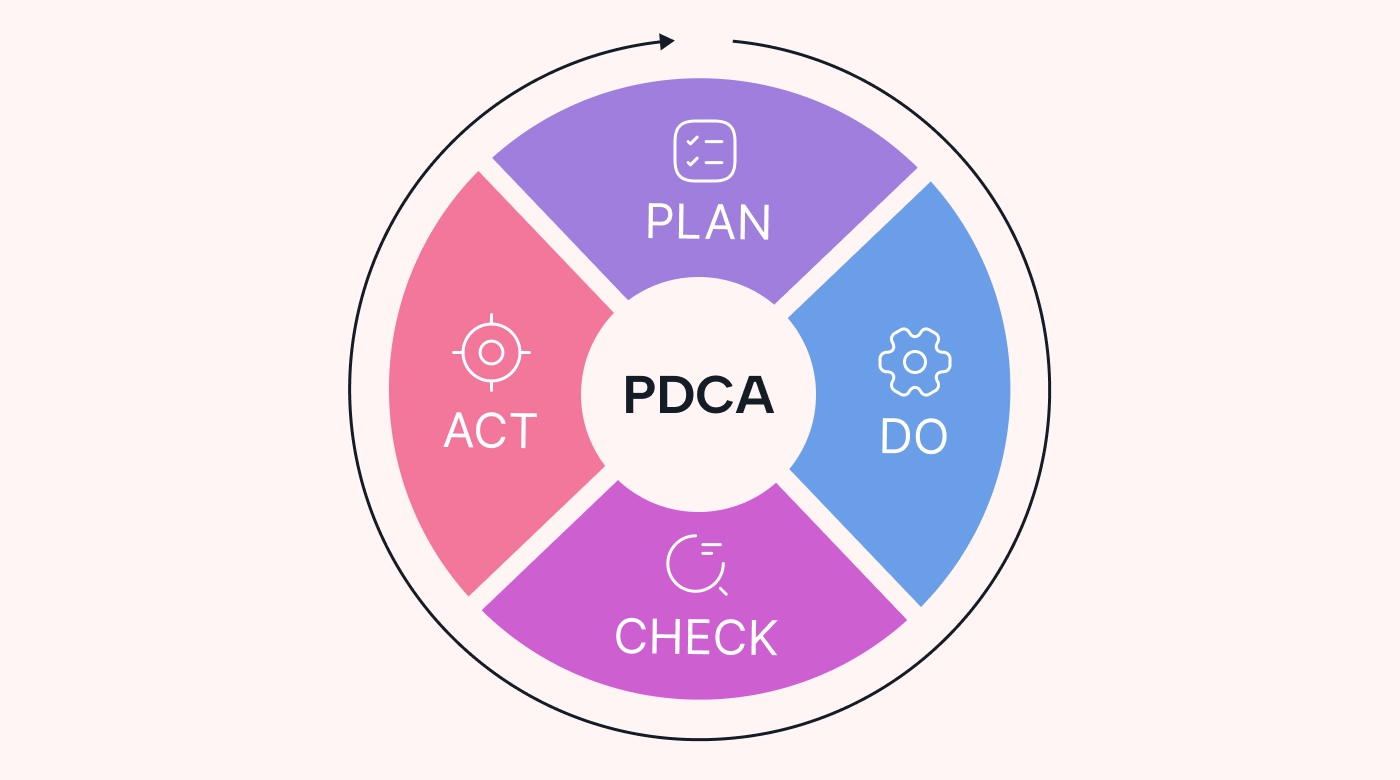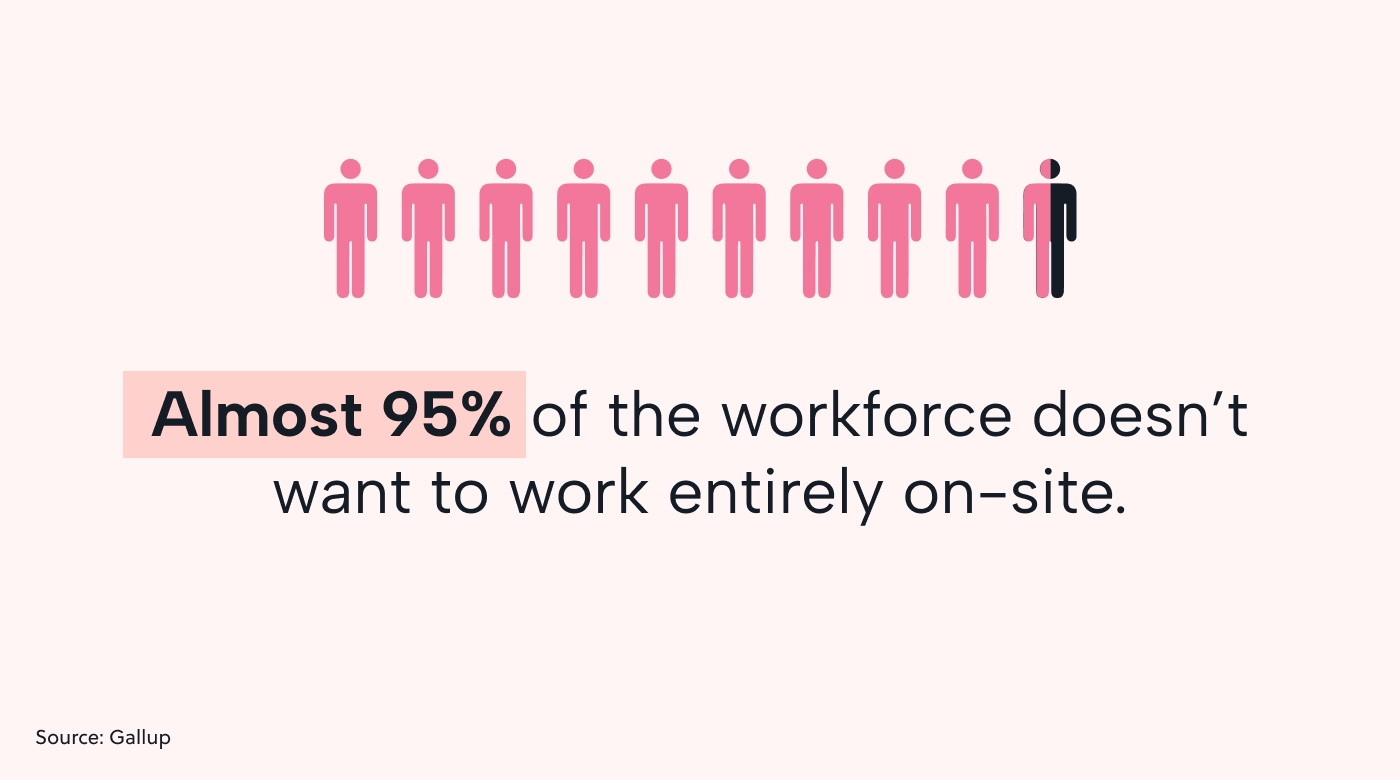If it was easy to excel, everyone would do it.
But many challenges get in the way of peak performance. Teams struggle to communicate and collaborate. Workloads accumulate. Projects drift. Previous “winning” solutions start to fall apart.
Here’s the thing: if we want peak productivity, we have to plan for it.
That’s where high-performance management steps in. It’s more than a way to manage — it’s a mindset and approach that brings out the best in teams.
In this article, we break down what high-performance management means, why it’s important, and the steps and best practices to successfully implement it.
What is high-performance management?
High-performance management is a leadership approach that maximizes a team’s potential. It involves regularly achieving results, improving processes, and raising the bar on what’s possible.
This approach is different than traditional management in three ways:
- It emphasizes empowerment over control.
- It champions continuous improvement.
- It aligns teams more strategically with their broader goals.
In other words, it’s not about increasing the workload or the pressure on the team — it’s about enabling the team to perform their best work.
While conventional management is more likely to manage resources and uphold the status quo, high-performance management encourages innovation and excellence.
For example, consider a software development company that adopts high-performance management. They empower their teams to choose projects and methodologies. They hold weekly innovation hours where developers can explore new technologies. And they link project outcomes with the teams’ broader objectives.
As a result, they consistently release groundbreaking software ahead of competitors.
What are the components of high-performance management?
Before we move forward, let’s break down the four main components needed to manage a team for high performance. Together, these elements form the foundation for succeeding with this method.
 |
Leadership
High-performance managers lead with the following qualities:
- Emotional intelligence
- A forward-looking vision
- Strong motivation skills
Unfortunately, effective leadership is becoming rare. A global study in 2023 found only 40% of respondents felt their teams had high-quality leaders. That’s a significant drop from just two years prior.
Culture
A high-performance culture creates a supportive work environment. It leads with strong organizational values, such as accountability and collaboration.
The term “psychological safety” has recently become a buzzword. But it’s a valuable concept to uphold in an organizational culture. It allows team members to take calculated risks without the fear of failure. And this is important if you want to see breakthrough innovations.
Strategy
Alignment between the team and their goals relies on good strategy. High-performance leaders make sure everyone is working toward the same objectives. They also understand each individual’s strengths and use that knowledge to assign tasks to the right people.
They carry out this strategy by:
- Setting goals
- Making decisions based on data
- Implementing feedback loops
Metrics
If you want to know how you’re doing — specifically, whether you’re improving — you have to measure it.
Measuring performance relies on both quantitative data (numbers, statistics, and ratings) and qualitative data (feedback and customer comments).
To assess progress and outcomes, leaders need to establish key performance indicators (KPIs) that bridge teams’ short-term results with their long-term objectives.
What are the benefits of high-performance management?
Managing to ensure peak performance offers significant advantages. Here are some of the long-term benefits:
Better productivity and efficiency
When well-managed, high-performing teams operate with cohesion and clarity. They have a shared focus on their goals. This alignment allows them to complete projects faster and with better outcomes.
Also, processes are streamlined, and resources are allocated well. That means minimal waste and downtime.
For example, with enhanced management, a team might dial in their processes and reduce their time-to-market for new product features. This could result in faster delivery times and higher customer satisfaction.
Improved employee satisfaction
One of the biggest advantages of managing for high-performance is the positive and empowering work environment. Employees feel genuinely valued and are offered many opportunities for growth and advancement. Their achievements are recognized, and their feedback is welcomed.
Employee satisfaction leads to lower turnover rates. Unfortunately, recent reports have found that many teams aren’t operating at this level.
 |
More adaptable
Today, teams need to adapt at the drop of a hat. Organizations constantly face these challenges:
- Market changes
- New technologies
- Shifts in competition
A high-performance culture encourages innovation and flexibility. Teams stay ahead of trends and continuously improve.
A 2022 report on global trends found that managers must be more adaptable in today’s landscape. They need to use a variety of methodologies and strategies, and they need to bridge the gap between workers in multiple locations — and even multiple countries.
Long-term sustainability
The most important feature of optimal management is sustaining high performance over time.
Any team can do well in the short term. High-performance management is about setting up an organization for the long game. That requires resilience, which can only arise through a strong culture. And most companies have a long way to go to get there.
Gallup has found only two in ten U.S. workers feel connected to their organizational culture. However, in teams that manage for peak employee performance, the rewards are endless.
How to implement high-performance management
Implementing high-performance management involves strategic planning, improving your culture, and taking practical steps to empower your team. Here’s how to effectively lay the groundwork and sustain momentum:
Set the stage
First, customize your strategies to fit your organizational needs. If your management approach doesn’t match the realities of your organization, that won’t help.
To better understand your needs, ask yourself the following questions:
- What are the strengths and weaknesses of our current management practices?
- Do our organizational goals align with how we manage?
- What feedback have our employees or stakeholders offered about our effectiveness?
With this background in place, develop a step-by-step action plan. It should be clear and specific, with actionable steps.
Outline the following:
- What needs to be achieved
- Who will be responsible for what
- What the timelines will be
- How success will be measured
A clear plan is like a roadmap for this transition. It sets expectations and lets everyone know how they’ll contribute.
Next, communicate the company vision and its benefits to the team.
 |
Anticipate questions and concerns so that you can address them before they even need to be brought up. Be enthusiastic about these improvements for infectious positivity.
Empower your team
One of the most critical factors for success is if your team takes ownership of your efforts toward optimal performance.
Give them a degree of autonomy over their tasks and decisions. That boosts their confidence and satisfaction, opening the door to innovation and taking initiative.
The clear expectations you laid out in the last step will provide accountability. Also, seek regular feedback from your team so that their voices are heard.
You’ll also want to create cross-functional teams — diverse groups of people with different skills and perspectives. The beauty of these teams is that they’re better equipped to solve complex problems and achieve lasting solutions.
Lastly, high performance shouldn’t come at the cost of employee health. In fact, undermining well-being will catch up with you eventually.
To ensure you have lasting success with your team, prioritize these variables:
- Work-life balance
- Mental and physical health
- Team morale
You can do this by making work schedules more flexible, enabling at least some remote work, offering mental health days, and providing resources such as counseling and wellness programs.
Leverage technology
Outdated technology is a surefire way to miss out on top-notch results. But it’s also counterproductive to have too many tools or ones that don’t match your team’s goals.
To find the best software for your teams, ask yourself the following questions:
- Does this technology align with our broadest goals?
- Will this technology simplify our processes or complicate them?
- Can this technology grow with our organization over time?
There are tools for tracking projects, lining up schedules, and maintaining communication. Some tools, such as Motion’s advanced calendar and task management app, do everything in one place.
Don’t overwhelm your staff with new tools and processes. Introduce software gradually and provide training for a comfortable shift.
6 best practices for sustaining high performance
These best practices are great go-to strategies for maintaining peak performance over time:
1. Learn continuously
Cultivate a growth mindset in your company where continuous learning is valued. Promote resilience by framing challenges as opportunities to learn and strengthen skills.
Make sure team members are regularly updating their skills and expanding their knowledge. Encourage and host workshops, courses, and seminars to do this.
2. Evolve as you go
Keep informed on industry trends and emerging technologies. This knowledge helps anticipate where markets could shift or what opportunities could emerge.
 |
Adopt the Plan, Do, Check, Act (PDCA) cycle, a system based on iteration, to help you move forward in a purposeful way.
Also, don’t make decisions in the dark. We now have more data at our fingertips than ever before. Use this information to guide interventions and improve performance.
3. Reward greatness
Money doesn’t hurt, but it’s not the only way to recognize someone. Personal gestures or acknowledging a team member’s contributions can sometimes go just as far.
Celebrate the small wins, too. Reward experimentation and creative problem-solving.
4. Develop future leaders
Your staff today could be your leaders tomorrow. But you have to invest in them to make that a reality.
Establish programs that nurture potential leaders. Offer structured training and mentoring. Development programs build a leadership pipeline for long-term success.
Make these programs part of employees’ personalized plans to prepare your brightest talent for leadership opportunities as they arise.
5. Master communication
Nothing can make or break management quicker than communication skills. Check in often and maintain open lines of communication.
Reinforce employee feedback through active listening and taking action.
6. Stay flexible
You’ll never establish a management approach and then be able to leave it alone. As time marches on, you’ll have to pivot and respond as necessary.
Fortunately, flexibility turns challenges into future strengths.
For example, one survey recently found that almost 95% of the workforce doesn’t want to work entirely on-site. So, you’re better off creating flexible work schedules.
 |
In other words, don’t resist new norms. Find ways to navigate them effectively while staying aligned with your top objectives.
Challenges in high-performance management
As you enact these changes in your management approach, it’s important to know the types of challenges you’re likely to confront as you move forward. Let’s take a look at a few of them:
Engagement at all levels
Peak performance requires all levels of the organization to be engaged and working together. This represents a challenge, as you may get leadership to buy into the change but struggle with the staff — or vice versa.
To overcome this hurdle, proactively seek out concerns and negative feelings among your team. Use surveys or feedback tools, for instance, to determine their engagement levels.
Resistance to change
Resisting change is a natural human tendency, but it can seriously derail your efforts as you pursue optimal performance.
Communication is your best friend in easing this resistance.
Express how the team will benefit from new methods. Show them how changes will help them achieve their biggest goals. Involve them in planning and decision-making, too.
Balancing the short- and long-term
Managers often grapple with the immediate pressures happening now and the vision they’re trying to achieve in the future.
 |
The short-term and long-term can sometimes be at odds. Agile methodologies are suitable for achieving a balance between the two. They provide managers with the flexibility to adjust and integrate new tools without disrupting ongoing operations.
The complexities of hybrid work
While hybrid work has brought many positive changes, it also has unique obstacles. Teams are dispersed, adding new challenges to collaboration and communication. Managing and checking in on staff often takes place virtually.
Thankfully, there are many collaboration platforms and asynchronous tools to help ease these challenges. Just be sure you have clear protocols and communication channels.
Boost your performance with Motion
We hope you better understand what high-performance management is and what it’s not. It’s not a band-aid or a quick fix. But, by implementing the actionable advice we just provided, you can work slowly and methodically toward operating at a higher level.
As you do this, use the best software to propel your success.
Motion can help boost performance by optmizing your schedules and streamlining project management. Many teams have found it an essential tool for peak performance.
Try Motion for free today!





